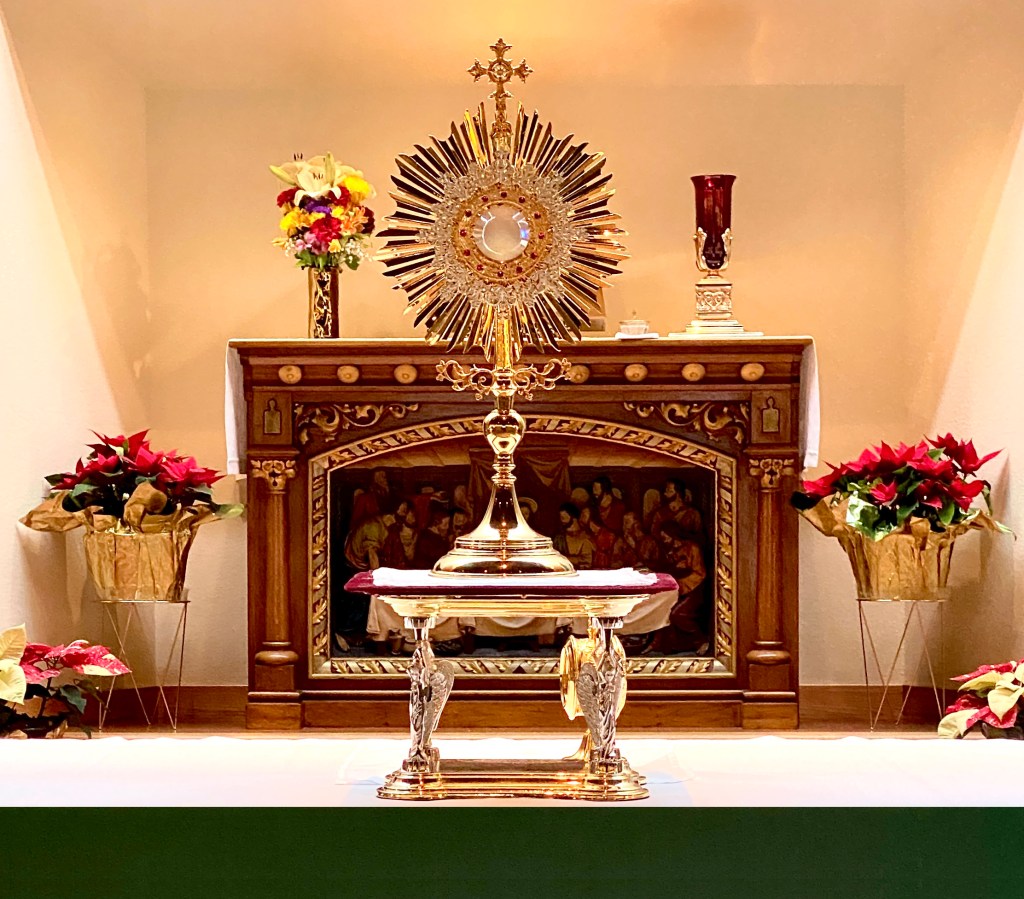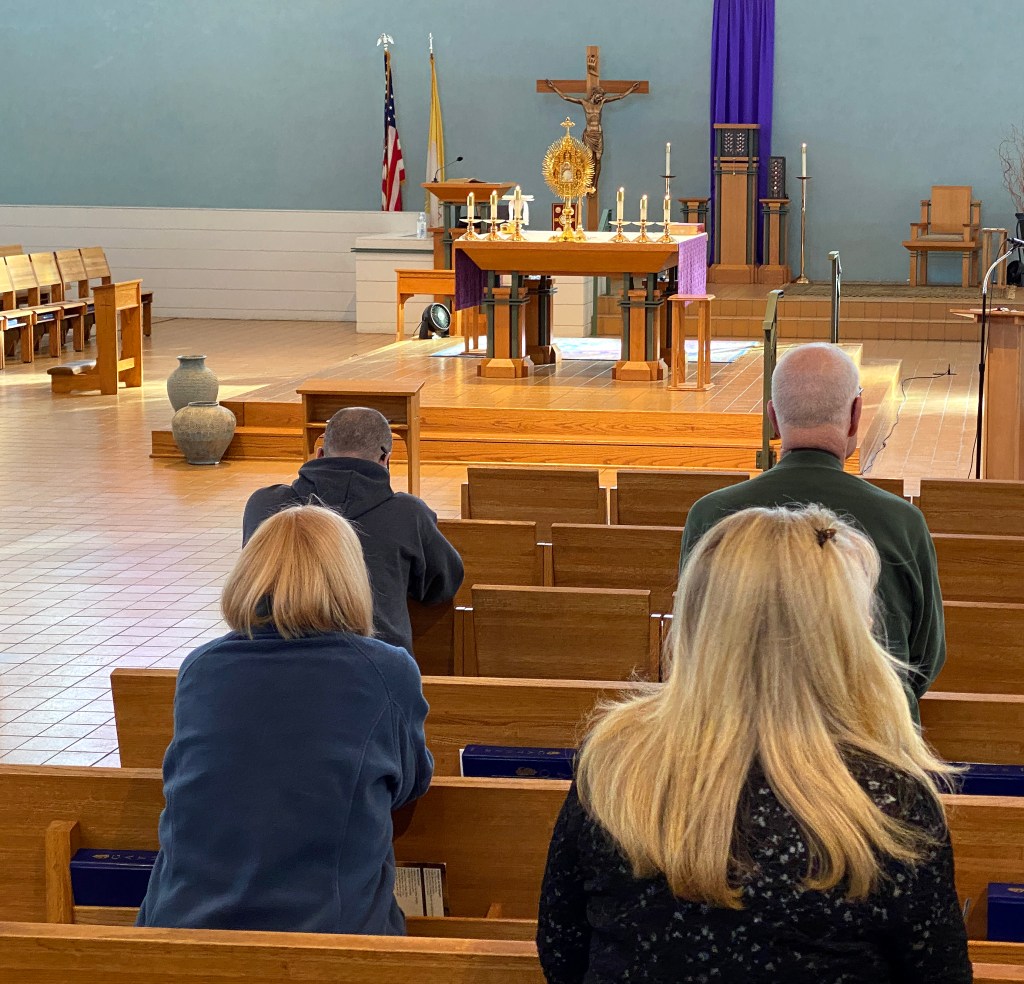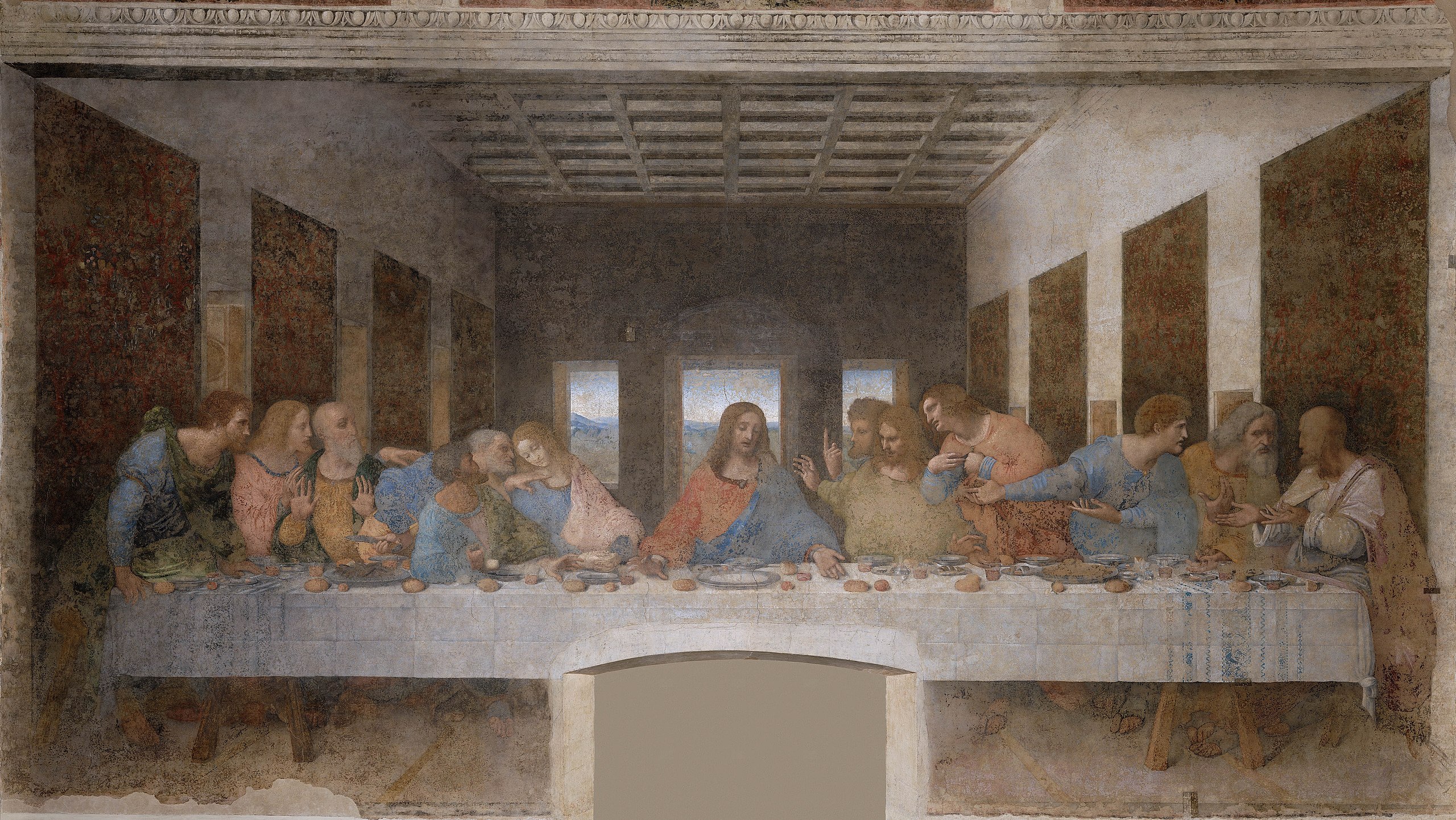Your cart is currently empty!

Madison Diocesan
Eucharistic Revival
Answer Christ’s Call: Proclaim His Eucharistic Love to the World!

Christ the Savior
with the Eucharist
by Juan de Juaness
What is the Eucharist?
The Eucharist is the very sacrifice of the Body and Blood of the Lord Jesus Christ which he instituted to perpetuate the sacrifice of the cross throughout the ages until his return in glory. Thus, he entrusted to his Church this memorial of his death and Resurrection. It is a sign of unity, a bond of charity, a paschal banquet, in which Christ is consumed, the mind is filled with grace, and a pledge of future glory is given to us.
Compendium, 271, CCC1322-1323; 1409
How is Christ present
in the Eucharist?
Jesus Christ is present in the Eucharist in a unique and incomparable way. He is present in a true, real and substantial way, with his Body and his Blood, with his Soul and his Divinity. In the Eucharist, therefore, there is present in a sacramental way, that is, under the Eucharistic species of bread and wine, Christ whole and entire, God and Man.
Compendium, 282, CCC1373-1375; 1413
What are the fruits of Holy Communion?
Holy Communion increases our union with Christ and with his Church. It preserves and renews the life of grace received at Baptism and Confirmation and makes us grow in love for our neighbor. It strengthens us in charity, wipes away venial sins, and preserves us from mortal sin in the future.
Compendium, 292, CCC1391-1397; 1416
What does the Eucharist represent
in the Church’s life?
It is the source and summit of all Christian life. In the Eucharist, the sanctifying action of God in our regard and our worship of him reach their high point. It contains the whole spiritual good of the Church, Christ himself, our Pasch.
Compendium, 273, CCC1337-1340; 1365, 1406
How is the Eucharist a memorial
of the sacrifice of Christ?
The Eucharist…makes present and actual the sacrifice which Christ offered to the Father on the cross once and for all on behalf of mankind. … The sacrifice of the cross and the sacrifice of the Eucharist are one and the same sacrifice. The priest and the victim are the same; only the manner of offering is different: in a bloody manner on the cross, in an unbloody manner in the Eucharist.
Compendium, 280, CCC1362-1367
When did Jesus Christ institute the Eucharist?
Jesus instituted the Eucharist on Holy Thursday “the night when he was betrayed” (1 Cor. 11:23), as He celebrated the Last Supper with His Apostles.
Compendium, #272

Come Unto Me
by Nancy Lee Rowan
How did He institute the Eucharist?
After he had gathered with his Apostles in the Cenacle, Jesus took bread in his hands. He broke it and gave it to them saying, “Take this and eat it, all of you; this is my Body which will be given up for you.” Then, he took the cup of wine in his hands and said, “Take this and drink of this, all of you. This is the cup of my Blood, the Blood of the new and everlasting covenant. It will be shed for you and for all so that sins may be forgiven. Do this in memory of me.”
Compendium, #273
In what way is the Eucharist a memorial of the sacrifice of Christ?
The Eucharist is a memorial in the sense that it makes present and actual the sacrifice which Christ offered to the Father on the cross, once and for all on behalf of mankind. The sacrificial character of the Holy Eucharist is manifested in the very words of institution, “This is my body which is given for you” and “This cup is the New Covenant in my Blood that will be shed for you” (Luke 22:19-20). The sacrifice of the cross and the sacrifice of the Eucharist are one and the same sacrifice. The priest and the victim are the same; only the manner of offering is different: in a bloody manner on the cross, in an unbloody manner in the Eucharist.
Why is the Holy Eucharist the paschal banquet?
The Holy Eucharist is the paschal banquet in as much as Christ sacramentally makes present his Passover and gives us his Body and Blood, offered as food and drink, uniting us to himself and to one another in his sacrifice.
Compendium, #287
Why is the Eucharist a “pledge of future glory”?
The Eucharist is a pledge of future glory because it fills us with every grace and heavenly blessing. It fortifies us for our pilgrimage in this life and makes us long for eternal life. It unites us already to Christ seated at the right hand of the Father, to the Church in heaven and to the Blessed Virgin and all the saints.
Compendium, #294
What is the meaning of transubstantiation?
Transubstantiation means the change of the whole substance of bread into the substance of the Body of Christ and of the whole substance of wine into the substance of his Blood. This change is brought about in the eucharistic prayer through the efficacy of the word of Christ and by the action of the Holy Spirit. However, the outward characteristics of bread and wine, that is the “eucharistic species,” remain unaltered.
Compendium, #283
Encounter Jesus
in the Eucharist!
The Mystery of the Eucharist in the Life of the Church, #5
“The Lord accompanies us in many ways, but none as profound as when we encounter him in the Eucharist.”
We are created to be with Jesus. The desire for God is written in the human heart, because man is created by God and for God… (CCC27). Jesus is present in the Eucharist in His totality. All that He is…is here! And He calls us to an encounter with Him in the Eucharist, His Sacrament of Love! (Dominicae Cenae).
It’s time to answer Christ’s call!
In response to Christ’s call, on Corpus Christi, 2022, America’s Bishops inaugurated a National Eucharistic Revival to renew and deepen our relationship with Jesus in the Holy Eucharist. The Madison Diocese joins this national revival with its own Congress.
In appreciation: We thank Deacon Scholbrock for designing the beautiful Congress logo (shown below). It reflects Jesus’ loving sacrifice on the Cross for our redemption and our share in His divine life. It brings us into the reality of His true presence–Body, Blood, Soul, and Divinity–in the Holy Eucharist. Finally, it shows our love for Jesus as we approach Him in both Communion and in Adoration.
_______________________________________
Keep the Congress Handbook as a Spiritual Guide
Keep the Handbook as a reference for prayers, hymns, Lectio divina, and Scripture.

_______________________________________
Adore Jesus in Your Local Parish!
Photos by Joe Ptak
Locations / Adoration guide / Lectio Divina / Mysteries & truths
Dare to Believe in the Eucharist.

“Dare to understand that you have an immortal soul and that you are going to live forever with God or without God. … But in this life right here, right now, you can taste that abundance and all that is waiting for you in the Eucharist. So, just take a bold step forward and…come back to Mass…come to believe…”
Dare to Believe: the Eucharist

Bishop Hying Introduces
the Eucharistic Revival.

God’s Presence Brings
Peace, Awe, and Humility.
“This intimate fellowship with Christ…delights us and gives us peace and rest…[an] increasing wonderment mingled with salutary fear… [H]is presence fills us with awe… [H]is holiness haunts us with a lively sense of our unworthiness, which forces us to rid ourselves of all that is earthly, that we may welcome and entertain our God…under the spell of the radiant beauty of His majestic Person.”
Transforming Your Life Through the Eucharist, Kane, 34

Eucharist, Source of
Our Healing and Hope!
Longer Version

The Eucharist Transforms.
“[T]here is a person-to-person exchange, a coming of the one into the other. The living Lord gives Himself to me, enters into me, and invites me to surrender myself to Him, so that the Apostle’s words come true: ‘[I]t is no longer I who live, but Christ who lives in me.'” (Gal 2:20)
Collected Works, Ratzinger, 54

Art Helps Us to See Truth.

The Eucharist is God’s
desire for union with us.
“For how could we account for this ineffable miracle of divine love in the Eucharist, if it were God’s intention to treat us merely as His servants, and if it were not His will to raise us above our nature and take us to His fatherly bosom? Whence comes this heavenly, divine nourishment, and to what end is it directed, if we are not born to a supernatural, divine life?”
The Mysteries of Christianity, Scheeben, 479

Adoro Te Devote Hymn

God makes His presence
known to those who love Him.
“[G]od can make His presence known in the heart of the one who loves Him by giving gentle inspirations to lead us to love Him more. The more the soul grows in love for God, the more docile it becomes to these inspirations of the Indwelling guest.”
Eucharist, Feingold, 511

O Salutaris Hostia Hymn

By faith, we enter into our
Lord’s Eucharistic hiddenness.
“We see Christ in the Blessed Sacrament, not with our bodily eyes, but with the highest and most wondrous spiritual vision—pure faith. As the Savior hid the glory and grandeur of the Godhead in His assumption of our nature, so too, in the Holy Eucharist, there is no visible disclosure of Him.
Transforming Your Life Through the Eucharist, Kane, 9
Consequently, to be one with Him in loving harmony, we must be hidden with Him; we must be lost in Him.“

The Bread of Life Discourse

We are partakers
of the divine
life in the Eucharist
“Those who feed on Christ in the Eucharist need not wait until the hereafter to receive eternal life: they already possess it on earth, as the first-fruits of a future fullness which will embrace man in his totality.
Ecclesia de Eucharistia, St. John Paul II, 18
For in the Eucharist we also receive the pledge of our bodily resurrection at the end of the world: ‘He who eats my flesh and drinks my blood has eternal life, and I will raise him up at the last day’ (Jn 6:54).”



________________________________________
Music’s Beauty Lifts Souls to Jesus!
Ubi Caritas: setting by Maurice Durufle
After hearing a Bach cantata, Pope Benedict XVI said, “In hearing this, one understands…the beauty that irresistibly expresses the presence of God’s truth.” We experience that same movement of soul when we hear, Ubi Caritas, a 9th century Gregorian chant written to be sung on Holy Thursday at the washing of the feet.
The anonymous writer used Matt 18:20 for inspiration: “For where two or three are gathered in my name, there am I in the midst of them.” And so, it brings us deep into the Last Supper when Jesus instituted the Holy Eucharist and the priesthood. In 1960, Maurice Durufle set this chant to music that will lift you to the beauty of Jesus’ love in the Holy Eucharist.
R: Where there is charity and love, God is also there.
The love of Christ has brought us together.
Let us rejoice and take delight in him:
Let us fear and love the living God;
Let us love one another with a sincere heart.
R: Ubi caritas et amor deus ibi est.
Congregavit nos in unum Christi amor.
Exsultemus et in ipso iucundemur.
Timeamus et amemus Deum vivum.
Et ex corde diligamus nos sincero.
________________________________________
Pray for Eucharistic Conversion!

He calls you to a deeper faith.
Lord Jesus, thank You for Your presence in the Holy Eucharist where I encounter You in an intimate, true, and loving union. Through the Holy Spirit, pour the graces and merits of Your Sacred Heart—into my own. Make the Eucharistic Congress a moment of conversion, turning me from my self-love to live the divine life with You as a child of God. Help me to truly realize the gift of Your Body and Blood.
I pray for all who come to the Congress, that You will set their hearts on fire for love of You in the Holy Eucharist. I pray that the Congress will strengthen our union as one Church—one in the Eucharist, in faith, and in love for You and others. Mary, our Mother, pray for us, that the Congress will glorify Your Son and help open souls to the encounter they need. Amen.
________________________________________
Listen to Recorded Eucharistic Talks!

Msgr. James Bartylla
Previously the Director of the Office of Vocation, since 2009, Monsignor James Bartylla serves as the Vicar General for the Madison Diocese.
He developed a series of homilies for the Eucharistic Revival, given at the Bishop O’Connor Center during noon Mass. He drew from talks given by Thomas Joseph White of the Thomistic Institute. One link brings you to the entire series.
Lawrence Feingold.
Lawrence Feingold is Associate Professor of Theology and Philosophy at Kenrick-Glennon Seminary, St. Louis, Missouri. He wrote several books, including, Eucharist: Mystery of Presence, Sacrifice, and Communion, lengthy but quite readable
He gives monthly talks for the St. Louis Eucharistic Revival, lasting about one hour each.


Dr. Brant Pitre
Distinguished Research Professor of Scripture at the Augustine Institute, Graduate School of Theology, Brant is a prolific author, including, Jesus and the Jewish Roots of the Eucharist, and A Catholic Introduction to the Bible: The Old Testament.
Formed offers a Eucharistic series featuring Brant. Click this link, type in parish, sign up, and search for Lectio Eucharist with Dr. Brant Pitre.
________________________________________
Six Steps Toward a Deeper
Relationship with Jesus in the Eucharist!
“‘Did not our hearts burn within us while he talked to us on the road…?’ … He was known to them in the breaking of the bread.”
Luke 24:32, 35a
In prayer, take six steps to draw closer to Jesus in the Eucharist:
- Encounter Jesus in the Eucharist.
- Repent and believe.
- Realize what you believe.
- Seek a deeper conversion, a transformation in Christ.
- Live the divine life.
- Live the liturgy in the world.
Read more and take those steps now and at the Congress.

________________________________________
Write a testimonial of your Eucharistic experience!
“Contemplation is a gaze of faith, fixed on Jesus. “I look at him and he looks at me“: this is what a certain peasant of Ars in the time of his holy curé used to say while praying before the tabernacle.“
Catechism of the Catholic Church, 2715
Testimonials support the experience and faith of other people. The reality of the Holy Spirit’s work, of the love of Jesus in the Eucharist, must be heard. And your written testimony will help. Please submit it on the linked form. Read them on the Testimonials page.

________________________________________

Marvel over Bl. Carlo Acutis’ Eucharistic Miracle Display
“The Eucharist is my highway to Heaven.“
Bl. Carlo Acutis
Before he passed away of leukemia in 2006, Bl. Carlo Acutis catalogued eucharistic miracles from all over the world. With the help of friends, he completed the project–160 panels–in 2-1/2 years. A replica of this display will be at the Congress. And you may schedule it for your parish as well.
________________________________________
Reflect on
Eucharistic Posts

- Be in God’s Presence Among His PeopleA man recently registered for the Madison Diocesan Eucharistic Congress (Sept. 29-Oct. 1) and left a message summing up the… Read more: Be in God’s Presence Among His People
- Six Steps for a Deeper Relationship with Jesus Christ in the EucharistBegin those steps at the Madison Diocesan Eucharistic Congress St. John the Baptist Catholic Church209 South St., Waunakee, WI September… Read more: Six Steps for a Deeper Relationship with Jesus Christ in the Eucharist
- Take Time to See and Live the Divine Life!The Madison Diocesan Eucharistic Congress (Sept. 29-Oct. 1, 2023, St. John the Baptist, Waunakee) will take time to help expose… Read more: Take Time to See and Live the Divine Life!
- Rediscover the Tenacity of Love!God planted an unquenchable desire to know and to love Him within our souls. St. John of the Cross describes… Read more: Rediscover the Tenacity of Love!
- True conversion brings holiness and a desire to be with Jesus in the Eucharist.Conversion takes time and discernment. St. Paul defines what it is to be converted from the world to a life… Read more: True conversion brings holiness and a desire to be with Jesus in the Eucharist.
- Make the Congress Your Eucharistic Retreat!Every day, Christ calls us to conversion! But, buried in our daily activities, we often fail to answer Him. … Read more: Make the Congress Your Eucharistic Retreat!

Sponsored by the Madison Diocese
Office of Worship 608-821-3000




























































